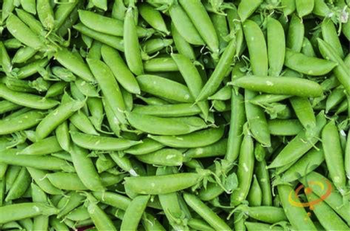Pea
-
Scientific NamePisum sativum
-
General InformationCool season annual legume. Vining cultivar. Originated in southwestern Asia. Includes shelling, snow, and snap peas. Snow and snap peas are among the highest value crops you can grow (highest yield per square foot). Bush and pole varieties available. Pole peas produce up to five times more than bush varieties.

-
When to Plant
Typically planted in November in the coastal areas and in February and March in all areas of Marin. November planting ensures blossoms in spring after winter storms. February planting is safer in areas of heavy frost and will produce peas before the heat of summer, which causes production to cease. Peas may be planted throughout the summer in the cooler microclimates.
-
Planting
Direct seeding is the easiest method. Peas may be started indoors three to four weeks before transplanting. Plant one to two inches deep and two inches apart, in double rows six to eight inches apart. Allow approximately 12 inches between double rows. Peas need support. Add a three to four foot trellis for bush varieties and a six to eight foot trellis for pole peas. Use chicken wire, hog wire, or mesh with openings not more than six inches.
-
Soil Requirements
Plant in fertile, well-drained soil with a pH of 5.5 to 6.8. Peas will germinate in soil temperatures that range between 40° to 70° degrees Fahrenheit. Peas fix nitrogen in the soil, so like beans may not need supplemental nitrogen fertilizer while growing.
-
Water Requirements
Peas need constant soil moisture to develop. Peas are shallow rooting so they do better with light, frequent irrigation. Avoid overwatering in heavier soil to prevent root rot.
-
Fertilizing
No fertilizer is necessary unless your soil is low in organic matter. Excess fertilizer encourages foliage growth and not pods.
-
Pollination
Self-pollinating.
-
Harvesting
Peas will begin to bear in eight to 10 weeks. Pick first pods on the bottom as this encourages more pods to form. Harvest shelling peas when the peas are large but before they turn tough. Harvest snow peas when the pods are still flat. Harvest snap peas most any time, but best when the peas inside are larger. Use pruners to cut peas off, as pulling may break the vine.
-
Storage
Peas are best when freshly picked from the garden but may be stored for short periods in the refrigerator in a crisper drawer with high humidity.
-
Good Varieties for Marin
Shelling Peas: ‘Oregon Trail’ ‘Maestro’
Snow/Sugar Pea: ‘Oregon Sugar Pod II’ ‘Oregon Giant’
Snap Peas: ‘Cascadia’ ‘Super Sugar Snap’ ‘Sugar Sprint’
-
Helpful Tips
Depending upon microclimate, seed every two weeks to extend harvest. Choose disease resistant varieties.
-
Common Problems
Powdery mildew – plant in cooler times of year when the fungus is less active.
Fungal diseases – plant in a different spot each year to minimize exposure to soil diseases.
-
Pests- Diseases & More

